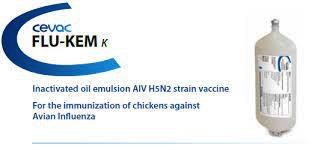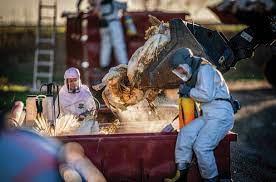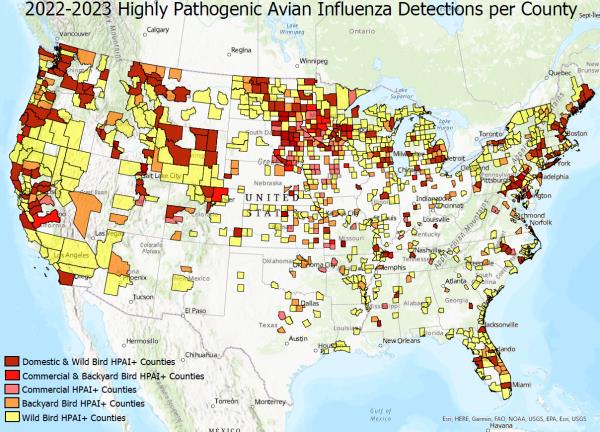Until October 4th, commercial farms in the U. S. were free of highly pathogenic avian influenza (HPAI) since April 2023, in the case of turkeys and December 2022 for broiler farms and egg production complexes. In the interim, there have been numerous cases of HPAI and isolation of H5N1 virus in backyard farms and from migratory waterfowl now undergoing their southward migration. In September, there were 32 isolations from either marine birds or waterfowl in the states of Alaska, Connecticut, Virginia, Iowa, Pennsylvania and Mississippi. These states encompass the Pacific, Mississippi and Atlantic Flyways. The current situation is eerily reminiscent of events preceding the 2022 epornitic. Europe is contending with persistence of H5N1 in wild birds with infection of backyard and commercial flocks following a pattern established over the past three years since the emergence of the panornitic H5N1 strain designated clade 2.3.4.4b.

The U.S. industry is dependent on USDA-APHIS for the control of HPAI. It is presumed that experience gained in 2015 and revised during the 2022 epornitics will be applied to any fall 2023 or spring 2024 outbreaks. In their activities, APHIS conforms to World Organization of Animal Health (WOAH) recommendations concerning diagnosis, flock disposal, surveillance and ultimately permission to restock. The Agency is responsible for reporting outbreaks of confirmed H5 and H7 avian influenza to WOAH and maintaining an export library for the benefit of the export segment of the industry.There are gaps in understanding the epidemiology of HPAI in relation to dissemination of virus by wild birds and how the pathogen specifically enters farms. Two long-delayed reports of minimal practical application were released by APHIS after reviewing a limited number of commercial egg farms and a larger number of turkey farms. Both of these studies have been reviewed and constructively criticized in EGG-NEWS and at regional meetings. Major deficiencies included a delay between outbreaks and collecting data, conducting telephone surveys using long, involved and frequently inappropriate questionnaires that ignored weather data. From USDA-APHIS publications and presentations the Agency apparently considers that high levels of structural and operational biosecurity are adequate to protect flocks. This is patently self-delusional given that there is sufficient anecdotal evidence that specific farms and complexes operating with high levels of biosecurity may have been infected by the aerogenous route. The APHIS studies disclosed that the presence of wild birds and proximity to an infected farm yielded high odds ratios denoting the intuitive risks of infection.

Given the spatial and temporal relationships between migratory birds and incident cases it is likely that many cases could not be attributed to defects in biosecurity. There are far too many U.S. turkey and egg production farms located in close proximity. Areas with a history of reoccurring HPAI are adjacent to wetlands and waterways that are the natural migratory routes of birds. Concentration of farms with large populations of turkeys or laying hens in the vicinity of expanses of water is contrary to accepted principles of conceptual biosecurity and cannot be overcome by investment in structural biosecurity and intensive application of operational biosecurity.
The industry is well aware of the potential for extensive losses on egg production and turkey farms located along the Central and Mississippi Flyways. For reasons possibly related to location, the bulk of the broiler industry was relatively unscathed during the 2015 and 2022 epornitics. This does not necessarily hold true for the fall of 2023 or in subsequent years.

There is a growing appreciation that attempting to permanently eradicate HPAI in the U.S. is an unachievable and Sisyphisan challenge. The infection is in reality introduced seasonally by millions of migratory birds with a predictable reoccurrence in areas previously affected. This is evidenced by losses in specific counties in Iowa, South and North Dakota and Minnesota. If HPAI is accepted as seasonally and regionally endemic, continuing to apply a program of detection and depopulation defies logic. The current approach will only achieve a small measure of control until migratory birds cease shedding virus or move on and cannot be expected to achieve eradication. This reality led regulatory authorities in France to abandon depopulation to suppress HPAI in the foie gras industry during 2022. Accordingly, France has initiated a vaccination program for commercial waterfowl in areas previously affected by HPAI. The predictable reaction by APHIS, following international agreements, was to immediately place an embargo on importation of poultry and non-processed products from France “to protect the U.S industry from HPAI”. This action was entirely devoid of reasoning given that HPAI is introduced and disseminated by migratory birds currently placing domestic flocks at risk.
Given the inevitability of HPAI entering the turkey and egg production sectors of the U.S. poultry industry, alternatives to the traditional response are needed especially if the disease is accepted to be at least regionally and seasonally endemic and transmitted over short distances by the aerogenous route. More cost-effective approaches are required other than depopulation of upwards of 50 million commercial birds as in 2022. Creating an immune population through vaccination of high-risk turkey and egg-production flocks in vulnerable areas would presumably reduce the number of farm outbreaks.
This commentator experienced the impact of velogenic viscerotropic Newcastle disease during the early 1970s that was in many respects analogous to the current situation with HPAI. Infection was suppressed by the intensive application of live attenuated vaccines to broilers by the aerosol route and combinations of live attenuated and inactivated oil immersion vaccines for broiler breeder pullets and egg production flocks.
Currently effective and safe avian influenza vaccines incorporating advanced technology are commercially available and are in wide use to immunize flocks. The USDA has not, to date, approved the use of vaccines against HPAI other than for the token administration to Californian condors, an extremely endangered species susceptible to the infection.
The major justification for this intransigence is the potential loss of the broiler export market valued at $5 billion annually. This is a simplistic and unsubstantiated value unfortunately with broad acceptance and is frequently cited by APHIS and proponents of the current policy. For the period January through August 2023, exports of broiler products amounted to 2.4 million metric tons representing approximately 15 percent of RTC production. Exports comprised 97 percent chicken parts principally leg quarters, but excluding feet, according to the National Chicken Council. The largest importer by volume and value was Mexico responsible for 20 percent of volume and 17 percent of value over the eight-month period. This Nation would in all probability not ban imports from the U.S. on the basis of limited vaccination to protect susceptible turkey and layer flocks in high-risk areas. Canada imported broiler meat to the value of $300 million over the eight-month period. The U.S. has agreements with Canada relating to regionalization. China purchased 12 percent of U.S. volume that represented 32 percent of value attributed to the fact that paws and feet comprised 66 percent of exports to China amounting to 72 percent of the value imported by that nation. Exports of leg quarters to China have fallen successively in volume and value over the past two years as they have become successively self-sufficient. Would this nation cease importing feet in the event of limited vaccination of turkeys and egg production flocks against HPAI in the U.S.? China has endemic HPAI, vaccinates to suppress infection, is generally irrational in regulatory decisions and has a history of discrimination against the U.S. in defiance of WOAH directives and WTO rules. It is possible that China would ban import of feet but will continue to obtain U.S. product through third-party nations facilitating trans-shipment. Other nations among the top-15 importers either have endemic HPAI, operate small domestic broiler industries, need a low-priced product or will follow WOAH principles on regionalization and compartmentalization.
Consistently maintaining that the U. S. would lose the $5 billion export market following limited regional vaccination is highly speculative and is used as to buttress an established USDA policy that serves one segment of the poultry industry. The FSIS representatives at regional and national meetings who continually justify their rejection of HPAI vaccination are basically reinforcing their “party line” and maintaining a potentially expensive status quo. Proponents of extensive depopulation in the face of inevitable reoccurrence of infection fail to appreciate that consumers in the U.S. were obliged to spend an additional $15 billion to purchase eggs in 2022. Shelf prices were on average $2 per dozen highercompared to what they would have been without depletion of close to 45 million laying hens in the fall and spring phases of the epornitic. Effectively in 2022 the U.S. industry was supplied from a national flock with 20 million fewer hens compared to the pre-HPAI complement of 330 million.
|

|
Vaccination both local and tactical will be required to protect commercial poultry flocks worldwide. The U.S. is no exception. It is often quoted in both EGG-NEWS and CHICK-NEWS that “Avian influenza is the Newcastle disease of the 2020s”. Accordingly, the USDA should use its best endeavors to initiate negotiations with trading partners and convince them of the need for vaccination. This will naturally be coupled with surveillance and certification of freedom from infection. In the age of PCR diagnostic assay and DIVA vaccines, regulatory authorities cannot hide behind the justification that “vaccines mask infection”.
Given that four commercial outbreaks have occurred over the past two weeks, APHIS should marshal its resources and conduct appropriate epidemiologic investigations in real time and either confirm or reject the presumption that the infection can be transmitted over relatively short distances by the aerogenous route. The disease will inevitably be introduced seasonally by migratory birds and if it is in actuality transmitted through air, will invalidate even high levels of operational biosecurity. Vaccination will be a necessary adjunct to support a more durable program of prevention limiting both the incidence and cost of HPAI. The Einstein dictum of the folly in repeating the same procedure and expecting a different result should be pondered and accepted by APHIS.